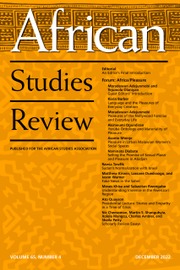Lydia Komape was known by many names over her long life (1935–2023). Listed at the beginning of this rich biography, these names testify to the multitudes her life contained. She was born Makwena Lydia Kgobe, daughter of Pedi-speaking Lutheran farmers in Matlala, Limpopo. Escaping the poverty following her family’s dispossession under “Betterment Schemes,” she married young, and unhappily. She became Lydia Komape, a hardworking mother in Johannesburg, laboring in the fields open to an African woman with a ninth-grade education: she was a seamstress, nursing aide, domestic worker, and—significantly—worker at the Heinemann Electric factory. By then, to avert carrying an African passbook, she was Lydia Kompe: an alias that could pass for “Coloured” (mixed race). In the 1970s and 1980s, the name Lydia Kompe became legendary in labor and rural land rights activism. She joined Parliament in 1994 as Lydia Komape-Ngwenya, adding the surname of her beloved second husband.
Friends referred to her more simply as Mam Lydia, and her biographer Kally Forrest follows suit, calling her by her first name throughout, “with the same respect as a surname” (2). This choice reflects the remarkably personal tenor of Forrest’s sources, featuring a score of interviews with her subject, as well as eighteen of her colleagues and family. Calling her subject by a consistent personal name also reflects Forrest’s admirable effort to capture who Lydia was as a woman, before and beyond her life in politics. Lydia emerges as open-minded, inspiring, and tenacious, always in pursuit of land and self-determination for women from rural backgrounds. In many ways, Lydia was an iconoclast—a divorcée, an activist, a pathbreaking parliamentarian. But Forrest emphasizes that Lydia never saw herself as a heroic individual: “She had grown up in a community and she entered the trade unions, where solidarity was all” (69).
Each chapter highlights both the sustaining joy and righteous anger that immersion in community could engender. Chapters One and Two offer an intimate portrait of her formative loss of land and escape from an abusive first marriage, the roots of her lifelong commitment to land rights and feminism. Chapters Three, Four, and Five explore her entrance into labor organizing. She joined the Metal and Allied Workers Union (Mawu) at Heinemann, soon before police violently charged workers in 1976. She became a full-time organizer with Mawu, then Transvaal secretary for the Transport and General Workers Union in 1978, organizing male truckers and women cleaners. In this dynamic and difficult period in which labor politics were central to anti-apartheid struggle, she made her home in an activist community in Crown Mines, Johannesburg. There she became a mentor for younger women like Aninka Claassens, who invited her to become a fieldworker with the Transvaal Rural Action Committee (Trac), an initiative of the Black Sash. As Chapters Six, Seven, and Eight demonstrate, Lydia’s work with Trac from 1986 drew rural women deeply into politics—reforming local governance and halting apartheid projects, as she built the new Rural Women’s Movement (RWM). Chapters Nine and Ten document this remarkable rural work in the late 1980s and 1990s, with highlights including enfranchising women to quash “independence” for the KwaNdebele Bantustan. Chapters Eleven through Fourteen reflect on her transition from activism to political power, as she became an African National Congress member of South Africa’s first democratic parliament. Although she felt tensions with MPs “from outside” (returned exiles, often more formally educated and urbane), she again had mutually enriching mentorship relationships with younger women, including Pregs Govender and Barbara Thompson. She played key roles in shaping legislation such as the Restitution of Land Rights Act (1994) and the Communal Property Associations Act (1996), and she was an active member of the committee on the status of women, building on work undertaken with Govender in the Women’s National Coalition. Yet from the end of Mandela’s term, she grew “increasingly disillusioned” with the slow pace of change and insufficient support for feminism (173). In 2009, she left Parliament, returning to Limpopo and the RWM—but she soon took a seat on the Limpopo legislature, retiring only in 2019, at age 84. Chapter Fifteen closes with Lydia’s vision for her funeral: “I want my rural women to be there at the forefront: people that know me well” (195).
This book deserves a wide audience, and it is written in an accessible and sometimes novelistic way that will appeal to nonspecialists. It was initiated by the Johannesburg Institute of Advanced Study, to address a gender imbalance in their biography project. Forrest suggests that Lydia’s life offers a gendered corrective to South Africa’s liberation narrative. Coming of age politically in midlife, “Lydia was in a different mould from the previous generation who had organised women with large gestures, big events and overt affiliations,” Forrest contends (137). “Her way of working was small and localised,” and she was able to avoid imprisonment, banning, or exile, remaining part of a “small band of activists working organisationally in South Africa” (137). Lydia’s life vividly shows how these “small” strategies could have major results. Yet Forrest overstates the lacuna around such activism (she does not engage with the work of Shireen Hassim, for example). While this limited historiographic engagement enables the narrative to move briskly, I would have enjoyed seeing more explicit comparisons and connections between Lydia and other women—before and during her time—who advanced gendered tactics of political survival.

